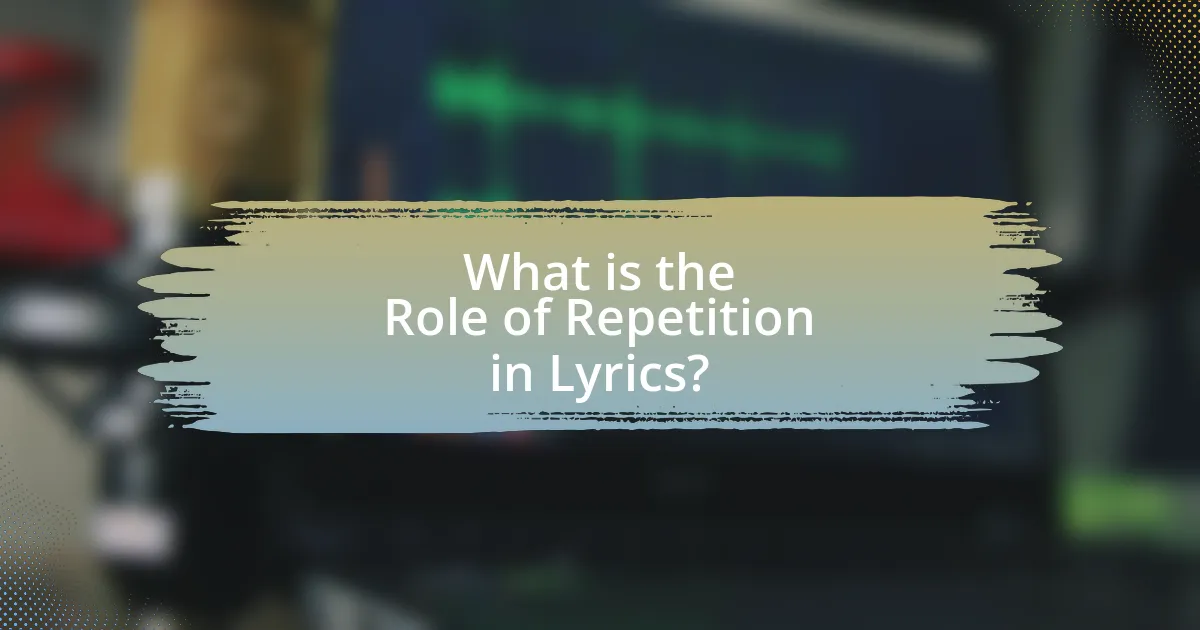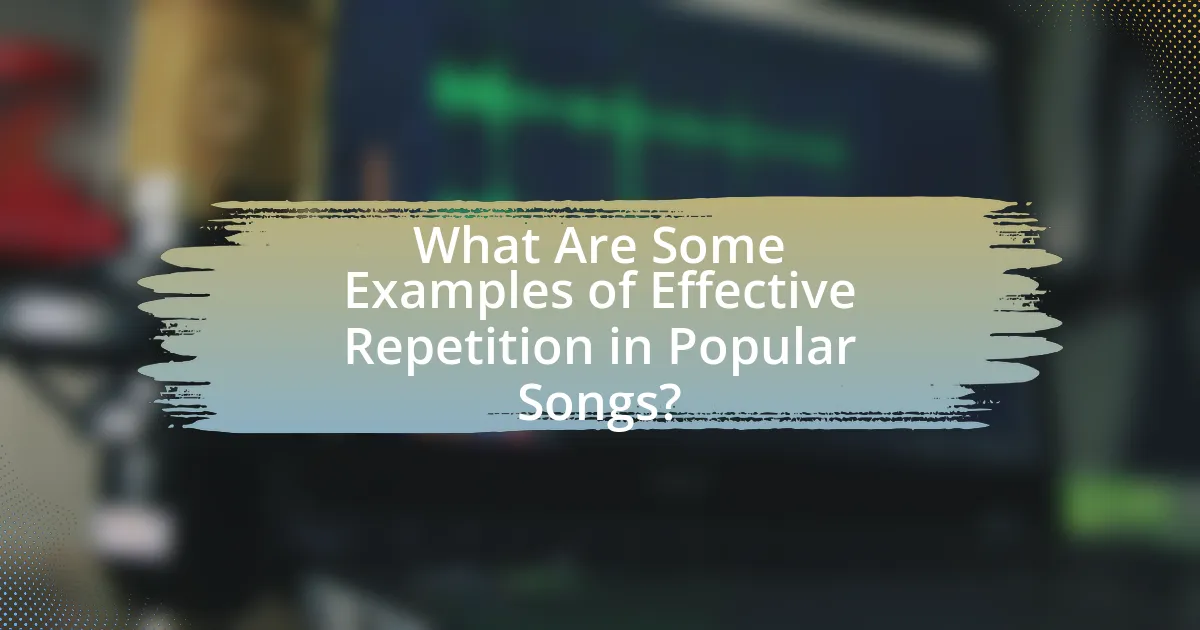The article focuses on the role of repetition in song lyrics, emphasizing its significance in enhancing memorability and emotional impact. It explores various types of repetition, such as anaphora, epistrophe, and refrains, and discusses their effectiveness in engaging listeners and reinforcing key themes. The article also examines how repetition can evoke emotional responses, build tension, and maintain listener interest, while providing practical tips for songwriters on how to use repetition effectively without overdoing it. Additionally, it highlights examples from popular songs and different musical genres that showcase masterful use of repetition.

What is the Role of Repetition in Lyrics?
Repetition in lyrics serves to enhance memorability and emotional impact. By repeating phrases or lines, songwriters create a hook that resonates with listeners, making the song easier to remember and sing along to. Research indicates that songs with repetitive elements often achieve higher chart success, as seen in the popularity of tracks like “Hey Jude” by The Beatles, which employs repetition to evoke strong emotional responses and engage audiences. This technique not only reinforces key themes but also fosters a sense of familiarity, encouraging listener connection and engagement.
Why is Repetition Important in Songwriting?
Repetition is important in songwriting because it enhances memorability and emotional impact. By repeating phrases or melodies, songwriters create hooks that resonate with listeners, making the song easier to remember and sing along to. Research indicates that songs with repetitive structures often achieve higher chart success, as seen in popular hits where choruses are frequently repeated, reinforcing the song’s central themes and emotions. This technique not only engages the audience but also solidifies the song’s message, making it more effective in conveying feelings and ideas.
How does Repetition Enhance Memorability in Lyrics?
Repetition enhances memorability in lyrics by reinforcing key phrases and themes, making them easier for listeners to recall. This technique leverages the psychological principle of the “spacing effect,” where repeated exposure to information strengthens memory retention. Studies show that songs with repetitive elements, such as choruses or hooks, are more likely to be remembered; for instance, research published in the journal “Psychology of Music” indicates that repeated musical phrases significantly improve recall rates among listeners. Thus, the strategic use of repetition in lyrics not only captures attention but also solidifies the song’s message in the listener’s memory.
What Emotional Responses Does Repetition Evoke in Listeners?
Repetition evokes emotional responses in listeners by enhancing familiarity, creating a sense of comfort, and reinforcing key messages. This emotional engagement occurs because repeated phrases or melodies can trigger memory recall and emotional resonance, leading to increased enjoyment and connection with the music. Research indicates that familiarity through repetition can lead to positive affective responses, as demonstrated in studies like “The Mere Exposure Effect,” which shows that repeated exposure to stimuli increases liking. Thus, repetition in lyrics effectively taps into listeners’ emotions, making the experience more impactful.
What Types of Repetition are Commonly Used in Lyrics?
Common types of repetition used in lyrics include anaphora, epistrophe, and refrain. Anaphora involves repeating a word or phrase at the beginning of successive lines or verses, which creates emphasis and emotional resonance. Epistrophe, on the other hand, is the repetition of a word or phrase at the end of successive lines, enhancing the lyrical impact. A refrain is a repeated line or group of lines, often found in choruses, that reinforces the central theme of the song. These techniques are widely utilized in various musical genres to enhance memorability and emotional connection, as evidenced by their prevalence in popular songs across decades.
What is the Difference Between Refrains and Choruses?
Refrains and choruses are both repeated sections in songs, but they serve different functions. A refrain typically consists of a few lines that are repeated throughout the song, often at the end of verses, and may not have a distinct melody. In contrast, a chorus is a more structured and melodic section that usually contains the main message of the song and is repeated after each verse. The distinction lies in the chorus being a complete musical and lyrical unit, while a refrain is often a shorter, less defined repetition. This differentiation is supported by common songwriting practices, where choruses are designed to be memorable and engaging, while refrains provide thematic continuity.
How Do Variations in Repetition Affect Song Structure?
Variations in repetition significantly influence song structure by creating dynamic contrasts and enhancing emotional impact. When repetition is varied, it can maintain listener interest and emphasize key themes or phrases, leading to a more engaging experience. For instance, a study by the University of Southern California found that songs with varied repetition patterns tend to have higher listener retention rates, as the unpredictability keeps the audience engaged. This strategic use of repetition can also delineate sections within a song, such as verses, choruses, and bridges, thereby contributing to the overall flow and coherence of the composition.
When Should Repetition be Used in Lyrics?
Repetition should be used in lyrics to emphasize key themes, enhance memorability, and create emotional resonance. By repeating phrases or lines, songwriters can reinforce the central message, making it easier for listeners to connect with the song. Research indicates that songs with repetitive elements are often more engaging and can lead to increased listener retention, as seen in popular music trends where choruses frequently utilize repetition to create hooks. This technique not only aids in memorization but also evokes stronger emotional responses, as repetition can heighten the impact of the lyrics on the audience.
What Are the Best Moments in a Song to Incorporate Repetition?
The best moments in a song to incorporate repetition are typically during the chorus, bridge, and key emotional peaks. Repetition in the chorus reinforces the main theme and makes it memorable, as seen in songs like “Rolling in the Deep” by Adele, where the repeated phrases enhance emotional impact. In the bridge, repetition can build tension and anticipation, exemplified in “We Will Rock You” by Queen, where the repeated stomps and claps create a powerful, unifying effect. Additionally, during emotional peaks, repetition can amplify feelings, as demonstrated in “Someone Like You,” also by Adele, where repeated lines evoke deep emotional resonance. These strategic placements of repetition enhance listener engagement and retention.
How Can Repetition Be Used to Build Tension or Release?
Repetition can be used to build tension by creating a sense of urgency and anticipation in lyrics. When a phrase or musical motif is repeated, it emphasizes its importance and can evoke emotional responses, leading listeners to feel heightened anxiety or excitement. For example, in songs like “Hey Jude” by The Beatles, the repeated phrase “na-na-na” builds emotional intensity as it progresses, drawing listeners into a climactic moment. Conversely, repetition can also facilitate release by providing resolution and comfort, as seen in the chorus of “Let It Be,” where the repeated phrase offers reassurance and closure. This duality of repetition in music effectively manipulates emotional dynamics, guiding the listener through tension and subsequent release.

How Can Songwriters Effectively Use Repetition?
Songwriters can effectively use repetition by strategically incorporating repeated phrases or lines to enhance memorability and emotional impact. This technique reinforces key themes and hooks, making the song more engaging for listeners. Research indicates that songs with repetitive elements, such as choruses or refrains, tend to have higher retention rates among audiences, as seen in popular music trends where catchy hooks dominate charts. For example, studies show that songs like “Hey Jude” by The Beatles utilize repetition to create an emotional connection, demonstrating that effective repetition can lead to greater listener engagement and commercial success.
What Techniques Can Enhance the Impact of Repetition?
Techniques that can enhance the impact of repetition include varying the context in which the repeated phrase is used, incorporating emotional delivery, and utilizing contrasting musical elements. Varying context allows the listener to perceive the repetition in different lights, thereby increasing its significance. Emotional delivery, such as changes in vocal intensity or dynamics, can evoke stronger feelings associated with the repeated lines, making them more memorable. Additionally, contrasting musical elements, like shifts in instrumentation or tempo during repetitions, can create a heightened sense of engagement and interest, reinforcing the repeated message. These techniques have been shown to improve listener retention and emotional connection, as evidenced by studies in music psychology that highlight the effectiveness of dynamic contrasts and emotional cues in enhancing memorability.
How Can Melody and Rhythm Complement Repeated Lyrics?
Melody and rhythm can enhance repeated lyrics by creating emotional resonance and reinforcing the message. When a melody is crafted to align with the emotional tone of the lyrics, it can amplify the listener’s connection to the repeated phrases. For instance, a rising melody can evoke feelings of hope or excitement, while a steady rhythm can instill a sense of stability and familiarity. Research indicates that repetition in music, combined with engaging melodic and rhythmic patterns, increases memorability and listener engagement, as seen in popular songs where catchy hooks are often repeated. This synergy between melody, rhythm, and repeated lyrics not only makes the song more appealing but also aids in conveying the intended emotional impact effectively.
What Role Does Context Play in the Effectiveness of Repetition?
Context significantly enhances the effectiveness of repetition by providing a framework that influences how the repeated material is perceived and retained. When repetition occurs within a relevant context, it aids in creating associations that strengthen memory recall and emotional resonance. For instance, studies show that information repeated in a meaningful context is more likely to be remembered than information presented in isolation, as contextual cues facilitate retrieval processes. This is supported by research indicating that contextual relevance can increase engagement and comprehension, making the repeated elements more impactful in the listener’s experience.
How Can Repetition Be Balanced with Other Song Elements?
Repetition can be balanced with other song elements by strategically varying its placement and intensity throughout the composition. For instance, incorporating contrasting verses or bridges can provide dynamic shifts that enhance the impact of repeated phrases. Additionally, adjusting the musical arrangement, such as changing instrumentation or tempo during repeated sections, can create a sense of progression and maintain listener interest. Research indicates that songs with a mix of repetition and variation tend to engage audiences more effectively, as evidenced by studies analyzing hit songs across genres, which show that successful tracks often utilize repetition alongside diverse melodic and harmonic elements to create a compelling listening experience.
What Are the Risks of Overusing Repetition in Lyrics?
Overusing repetition in lyrics can lead to listener fatigue and diminished emotional impact. When lyrics rely too heavily on repeated phrases, they may become monotonous, causing audiences to disengage. Research indicates that excessive repetition can reduce the novelty of a song, making it less memorable and less likely to resonate with listeners. For example, a study published in the Journal of Experimental Psychology found that while some repetition can enhance recall, too much can lead to a decline in enjoyment and interest. Therefore, striking a balance in the use of repetition is crucial for maintaining listener engagement and emotional connection.
How Can Songwriters Maintain Listener Engagement with Repetition?
Songwriters can maintain listener engagement with repetition by strategically using memorable hooks and refrains that resonate emotionally. This technique reinforces key themes and makes the song more accessible, as studies show that repeated exposure to familiar melodies and lyrics enhances listener retention and enjoyment. For instance, a study published in the Journal of Experimental Psychology found that repeated musical phrases lead to increased familiarity, which in turn boosts listener preference. By balancing repetition with variation, songwriters can keep the audience engaged while ensuring that the repeated elements remain fresh and impactful.

What Are Some Examples of Effective Repetition in Popular Songs?
Effective repetition in popular songs can be seen in tracks like “Hey Jude” by The Beatles, where the phrase “na-na-na” is repeated to create an anthemic feel, enhancing emotional engagement. Another example is “We Will Rock You” by Queen, which uses the repetitive stomp-stomp-clap pattern to build anticipation and audience participation. Additionally, “Rolling in the Deep” by Adele employs the repetition of the phrase “you could have had it all” to emphasize regret and longing, making the emotional impact more profound. These examples illustrate how repetition can enhance memorability and emotional resonance in music.
Which Artists are Known for Their Use of Repetition?
Artists known for their use of repetition include Steve Reich, Andy Warhol, and the band The Beatles. Steve Reich, a prominent minimalist composer, employs repetitive musical phrases to create complex textures and rhythms, as seen in works like “Music for 18 Musicians.” Andy Warhol, a leading figure in the visual arts, utilized repetition in his silkscreen prints, notably the “Campbell’s Soup Cans,” to comment on consumer culture. The Beatles frequently used repetition in their lyrics and melodies, exemplified in songs like “Hey Jude,” where the repeated “na-na-na” section enhances emotional impact. These artists effectively demonstrate how repetition can be a powerful tool in various art forms.
What Specific Songs Showcase Masterful Use of Repetition?
“Hey Jude” by The Beatles showcases masterful use of repetition, particularly in its chorus where the phrase “na-na-na” is repeated multiple times, creating an anthemic quality. Another example is “We Will Rock You” by Queen, which employs a simple, repetitive beat and lyrics that engage listeners and encourage participation. Additionally, “Someone Like You” by Adele features the repetition of key phrases that emphasize emotional impact, reinforcing the song’s themes of heartbreak. These songs effectively utilize repetition to enhance memorability and emotional resonance.
How Have Different Genres Approached Repetition in Lyrics?
Different genres have approached repetition in lyrics in distinct ways, reflecting their unique stylistic and cultural contexts. For instance, pop music often utilizes catchy choruses and repetitive hooks to enhance memorability and audience engagement, as seen in hits like “Call Me Maybe” by Carly Rae Jepsen, where the chorus is repeated multiple times. In contrast, hip-hop frequently employs repetition for emphasis and rhythm, with artists like Drake using repeated phrases to create a hypnotic effect in tracks such as “God’s Plan.” Rock music, on the other hand, may use repetition to build intensity, as demonstrated in songs like “We Will Rock You” by Queen, where the repeated beat serves to energize live audiences. These genre-specific strategies illustrate how repetition serves various purposes, from enhancing catchiness in pop to reinforcing lyrical themes in hip-hop and rock.
What Practical Tips Can Help Songwriters Use Repetition Effectively?
To use repetition effectively, songwriters should focus on creating memorable hooks, emphasizing key themes, and varying the repetition’s context. Memorable hooks, such as catchy choruses, can enhance listener retention, as evidenced by the popularity of songs like “Hey Jude” by The Beatles, where the repeated phrase reinforces emotional impact. Emphasizing key themes through repetition allows songwriters to highlight important messages, making them resonate more with the audience. Additionally, varying the context of repetition—such as changing the arrangement or instrumentation—can keep the listener engaged while maintaining familiarity, as seen in many successful pop and rock songs.
How Can Songwriters Experiment with Repetition in Their Work?
Songwriters can experiment with repetition by varying the placement, structure, and intensity of repeated phrases or lines within their lyrics. For instance, they can use repetition in the chorus to create a memorable hook, while altering the verses to provide contrast and maintain listener interest. This technique is supported by the fact that many successful songs, such as “Hey Jude” by The Beatles, utilize repetition to enhance emotional impact and audience engagement. By strategically repeating certain elements, songwriters can reinforce themes and evoke specific feelings, making their work more resonant and impactful.
What Common Mistakes Should Be Avoided When Using Repetition?
Common mistakes to avoid when using repetition include overusing phrases, which can lead to monotony, and failing to vary the context or delivery, resulting in diminished impact. Overuse of repetition can cause listeners to disengage, as studies show that excessive repetition can reduce emotional resonance and listener interest. Additionally, neglecting to align repeated elements with the song’s overall theme can create confusion, undermining the intended message.





